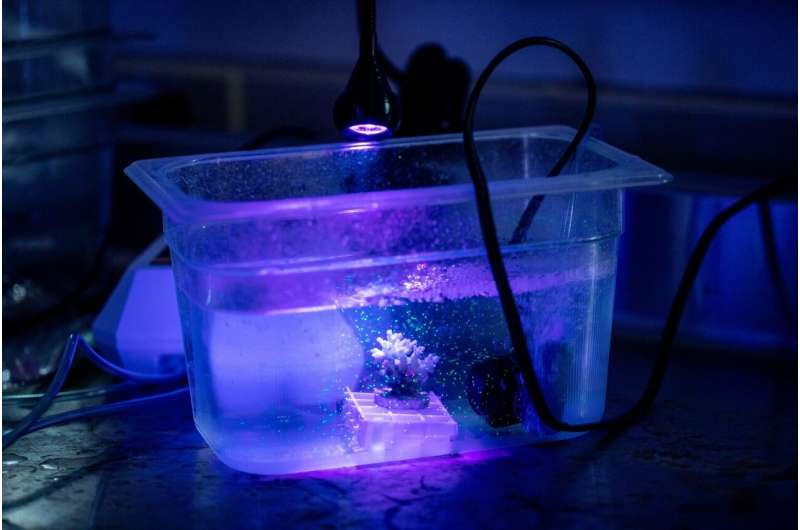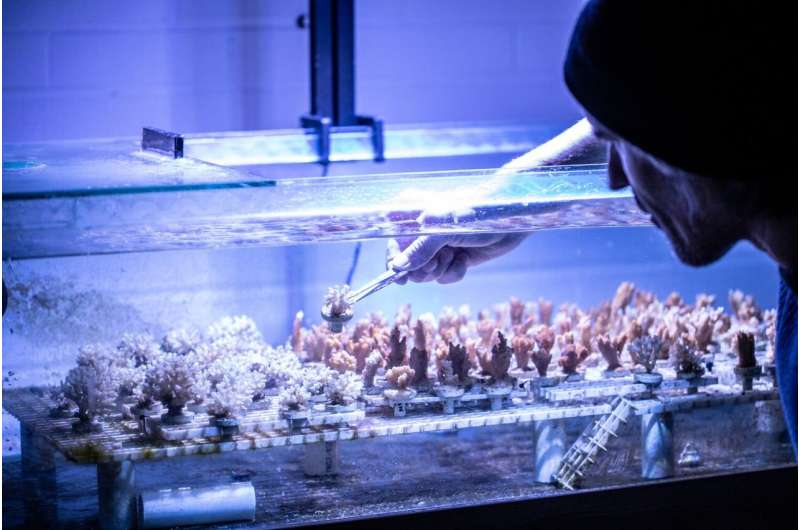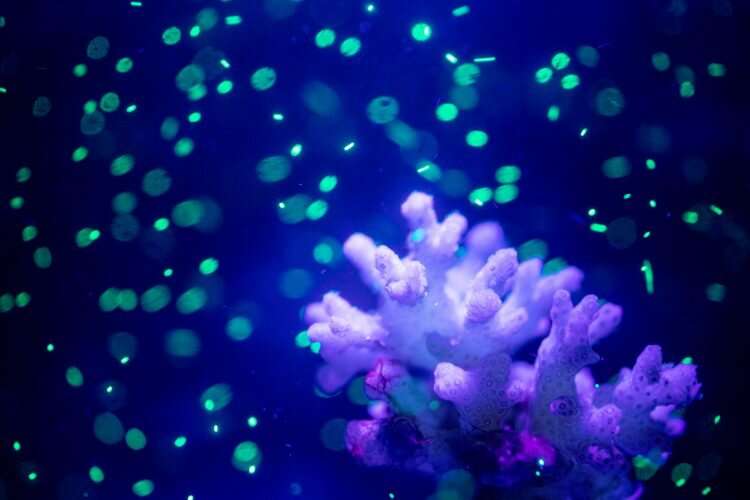For some corals, meals can come with a side of microplastics

Tiny microplastic particles are about as common in the ocean today as plastic is in our daily lives.
Synthetic clothing, containers, bottles, plastic bags and cosmetics all degrade and release microplastics into the environment. Corals and other marine organisms are eating microplastics that enter the waterway. Studies in this emerging field show some harmful effects, but it's largely unknown how this ubiquitous material is impacting ocean life.
A new experiment by the University of Washington has found that some corals are more likely to eat microplastics when they are consuming other food, yet microplastics alone are undesirable. Two coral species tested responded differently to the synthetic material, suggesting variations in how corals are adapting to life with microplastics. The study was published Dec. 3 in the journal Scientific Reports.
"The more plastic we use, the more microplastics there are, and the more corals are going to be exposed," said lead author Jeremy Axworthy, a UW doctoral student in the School of Aquatic and Fishery Sciences. "Our study found that some corals probably won't eat microplastics and will keep going about their daily business. But some might—and if they happen to be sensitive to warmer ocean temperatures or other stressors, this is just another compounding factor to be worried about."
Corals are tiny animals that are rooted to the reef or rocks on the ocean floor. They use tentacle-like arms to sweep food into their mouths. Many rely on algae for energy, but most also consume drifting animals for survival.
This study is the first to examine whether corals eat microplastics when exposed to warmer water, which is expected to accelerate with climate change. Rising ocean temperatures can be deadly for coral: warm water stresses them, causing corals to lose their symbiotic algae partner that undergoes photosynthesis and provides energy for them to survive. When this happens, coral bleaching and eventual death can occur.

But some corals have adapted to bleaching by shifting their diets to feed on tiny marine organisms called zooplankton, which provide an alternate energy source. As they munch on these small animals—often the same size as microplastics—the research team wondered whether they also were ingesting plastic fragments.
The experiment shows corals do eat microplastics when they switch to a zooplankton diet, adding one more stressor for corals in a changing ocean environment.
"Microplastics are not as simple as a life-or-death threat for corals—it's not that black or white," said senior author Jacqueline Padilla-Gamiño, assistant professor at the UW School of Aquatic and Fishery Sciences. "It's about total energy lost. If corals constantly are dealing with microplastics, it might not kill them, but there will be less energy for them to grow and to reproduce."
The researchers collected two species of common corals off the east coast of Oahu, Hawaii, and exposed half of each species to warmer water for several weeks to induce stress and bleaching. Then they ran four different feeding experiments on both bleached and non-bleached corals: corals were fed only microplastics; only a type of zooplankton; microplastics and zooplankton; or nothing.
After dissecting the coral polyps, researchers found that corals stressed by warmer temperatures actually ate much less than their counterparts in normal seawater. This was unexpected and possibly due to stress from high water temperatures. However, one of the two species, known for its voracious eating habits in the wild, consumed microplastics only while also eating zooplankton. Neither coral species ate microplastics alone.
The researchers don't know why one species of coral readily ate microplastics in the presence of other food, but avoided microplastics when they were the only thing on the menu. They suspect that this species of coral can read certain chemical or physical cues from the plastics and the prey, but might not be able to distinguish between the two when both are present.

It's also possible the plastic used in this experiment is less desirable to corals, and that plastics with a different chemical makeup could, in fact, be tasty to corals. The researchers plan to test the "tastiness" of other types of microplastics, such as synthetic fibers from clothing.
Ultimately, some coral species likely face greater risks from exposure to microplastics than others, the study found. The researchers will look next at impacts on the physiology of corals that are exposed over a longer period to microplastics.
"Knowing that will provide a lot more context to this work," Axworthy said. "We need to know the full physiological impacts of chronic exposure to microplastics on corals, especially at increased temperatures, to understand how serious the problem is."
In the meantime, the problem of microplastics isn't going away. A 2014 estimate found between 15 and 51 trillion microplastic particles in the oceans, and plastic waste entering the oceans is expected to increase tenfold between 2010 and 2025.
"It's important when talking about waste management to think big picture—what are we putting in the oceans?" Padilla-Gamiño said. "We don't know where plastic goes, where it stays, who grabs it, and what are the mechanisms by which we get it back. We are just at the tip of understanding these implications."
More information: Jeremy B. Axworthy et al, Microplastics ingestion and heterotrophy in thermally stressed corals, Scientific Reports (2019). DOI: 10.1038/s41598-019-54698-7
Journal information: Scientific Reports
Provided by University of Washington




















